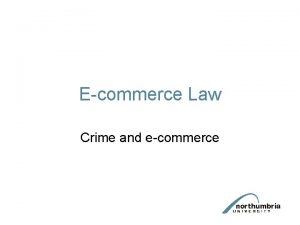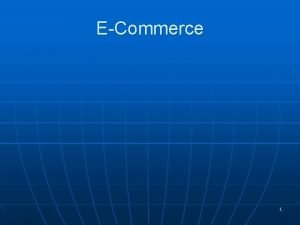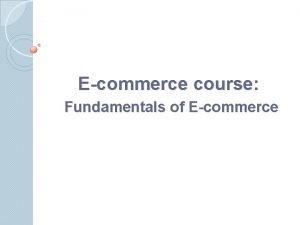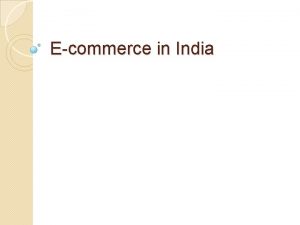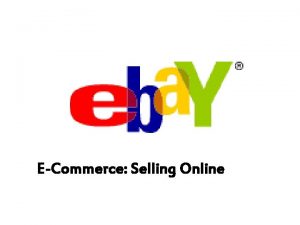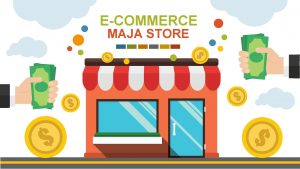Ecommerce and the Internet n n Ecommerce refers





















- Slides: 21

E-commerce and the Internet n n E-commerce refers to the use of the Internet and the Web to transact business. More formally, e-commerce is about digitally enabled commercial transactions between and among organizations and individuals. E-commerce began in 1995 when one of the first Internet portals, Netscape. com, accepted the first ads from major corporations and popularized the idea that the Web could be used as a new medium for advertising and sales. The very rapid growth in e-commerce in the early years created a market bubble in e-commerce stocks, and the “dot-com” bubble burst in March 2001.

The Growth of E-commerce

The Growth of E-commerce n Business Transformation n n E-commerce remains the fastest growing form of commerce when compared to physical retail stores, services, and entertainment. The first wave of e-commerce transformed the business world of books, music, and air travel. In the second wave, nine new industries are facing a similar transformation scenario: marketing and advertising, telecommunications, movies, television, jewelry and luxury goods, real estate, online travel, bill payments, and software.

The Growth of E-commerce n Business Transformation (Cont. ) n n The breadth of e-commerce offerings grows, especially in the services economy of social networking, travel, information clearinghouses, entertainment, retail apparel, appliances, and home furnishings. Pure e-commerce business models are refined further to achieve higher levels of profitability, whereas traditional retail brands, such as Sears, JC Penney, L. L. Bean, and Walmart, use e-commerce to retain their dominant retail positions.

The Growth of E-commerce n Business Transformation (Cont. ) n n n The online demographics of shoppers broaden to match that of ordinary shoppers. Small businesses and entrepreneurs continue to flood the e-commerce marketplace, often riding on the infrastructures created by industry giants, such as Amazon, Apple, and Google, and increasingly taking advantage of cloud-based computing resources. Mobile e-commerce begins to take off in the United States with location-based services and entertainment downloads including e-books.

The Growth of E-commerce n Technology Foundations n n n Wireless Internet connections (Wi-Fi, Wi. Max, and 3 G/4 G smart phones) grow rapidly. Powerful handheld devices support music, Web surfing, and entertainment as well as voice communication. Podcasting and streaming take off as mediums for distribution of video, radio, and usergenerated content. The Internet broadband foundation becomes stronger in households and businesses as transmission prices fall. More than 80 million households had broadband cable or DSL access to the Internet in 2010.

The Growth of E-commerce n Technology Foundations (Cont. ) n n Social networking software and sites such as Facebook, My. Space, Twitter, Linked. In, and thousands of others become a major new platform for ecommerce, marketing, and advertising. (Facebook hits 500 million users worldwide. ) New Internet-based models of computing, such as cloud computing, software as a service (Saa. S), and Web 2. 0 software greatly reduce the cost of ecommerce Web sites.

The Growth of E-commerce n New Business Models Emerge n n More than half the Internet user population have joined an online social network, contribute to social bookmarking sites, create blogs, and share photos. Together these sites create a massive online audience as large as television that is attractive to marketers. The traditional advertising business model is severely disrupted as Google and other technology players such as Microsoft and Yahoo! seek to dominate online advertising, and expand into offline ad brokerage for television and newspapers.

The Growth of E-commerce n New Business Models Emerge (Cont. ) n n Newspapers and other traditional media adopt online, interactive models but are losing advertising revenues to the online players despite gaining online readers. Online entertainment business models offering television, movies, music, sports, and e-books surge, with cooperation among the major copyright owners in Hollywood and New York with the Internet distributors like Google, You. Tube, Facebook, and Microsoft.

Why E-commerce is Different n n n Why has e-commerce grown so rapidly? The answer lies in the unique nature of the Internet and the Web. The Internet and e-commerce technologies are much more rich and powerful than previous technology revolutions like radio, television, and the telephone. There are eight unique features of e-commerce technology. - Ubiquity Global Reach Universal Standards Richness - Interactivity Information Density Personalization/Customization Social Technology

Features of E-commerce Technology n Ubiquity n n n Internet/Web technology is available everywhere: at work, at home, and elsewhere via mobile devices. The marketplace is extended beyond traditional boundaries and is removed from a temporal and geographic location. “Marketspace” anytime, is created; shopping can take place anywhere. Customer convenience is enhanced, and shopping costs are reduced. Global Reach n n n The technology reaches across national boundaries, around the Earth. Commerce is enabled across cultural and national boundaries seamlessly and without modification. The marketspace includes, potentially, billions of consumers and millions of businesses worldwide.

Features of E-commerce Technology n Universal Standards n n n Richness n n n There is one set of technology standards, namely Internet standards. With one set of technical standards across the globe, disparate computer systems can easily communicate with each other. Video, audio, and text messages are possible. Video, audio, and text marketing messages are integrated into a single marketing message and consumer experience. Interactivity n n The technology works through interaction with the user. Consumers are engaged in a dialog that dynamically adjusts the experience to the individual, and makes the consumer a coparticipant in the process of delivering goods to the market.

Features of E-commerce Technology n Information Density n n Personalization/Customization n The technology reduces information costs and raises quality. Information processing, storage, and communication costs drop dramatically, whereas currency, accuracy, and timeliness improve greatly. Information becomes plentiful, cheap, and more accurate. The technology allows personalized messages to be delivered to individuals as well as groups. Personalization of marketing messages and customization of products and services are based on individual characteristics. Social Technology n n User content generation and social networking. New Internet social and business models enable user content creation and distribution, and support social networks.

Internet Business Models n n n E-tailer – sells physical products directly to consumers or to individual businesses (such as Amazon. com and Red. Envelope. com) Transaction broker – saves users money and time by processing online sales transactions and generating a fee each time a transaction occurs (such as ETrade. com and Expedia. com) Market creator – provides a digital environment where buyers and sellers can meet, search for products, display products, and establish prices for those products, and can serve consumers or B 2 B e-commerce, generating revenue from transaction fees (such as e. Bay. com and Priceline. com)

Internet Business Models n n n Content provider – creates revenue by providing digital content, such as news, music, photos, or video, over the Web (such as WSJ. com, Getty. Images. com, i. Tunes. com and Games. com). The customer may pay to access the content, or revenue may be generated by selling advertising space. Community provider – provides an online meeting place where people with similar interests can communicate and find useful information (such as Facebook. com, My. Space. com, i. Village. com and Twitter) Portal – provides initial point of entry to the Web along with specialized content and other services (such as Yahoo. com, Bing. com and Google. com)

Internet Business Models n Service provider – provides Web 2. 0 applications such as photo sharing, video sharing, and user-generated content (in blogs and social networking sites) as services, and provides other services such as online data storage and backup (such as Google Apps and Photobucket. com)

M-commerce n n The use of handheld wireless devices for purchasing goods and services from any location is termed mobile commerce or M-commerce. Both business-to-business and business-to-consumer ecommerce transactions can take place using m-commerce technology. The main areas of growth in mobile e-commerce are locationbased services; software application sales at stores; entertainment downloads of ring tones, music, video, and TV shows; mobile display advertising; direct shopping services; and e-book sales. M-commerce applications have taken off for services that are time-critical, that appeal to people on the move, or that accomplish a task more efficiently than other methods.

Mobile Commerce Revenues

M-commerce n Location-based Services n n n Foursquare is a free social networking application that allows you to connect with friends and update their location. Points are awarded for “checking in” at designated venues. Users choose to have their check-ins posted on their accounts on Twitter, Facebook, or both. Users also earn badges by checking in at locations with certain tags, for check-in frequency, or for the time of check-in. More and more restaurants, bars, and other businesses use Foursquare to attract customers with promotions.

M-commerce n Banking and Financial Services n n n Banks and credit card companies are rolling out services that let customers manage their accounts from their mobile devices. JPMorgan Chase and Bank of America customers can use their cell phones to check account balances, transfer funds, and pay bills. Wireless Advertising and Retailing n n Although the mobile advertising market is currently small ($784 million), it is rapidly growing, as more and more companies seek ways to exploit new databases of locationspecific information. In 2010, shoppers ordered about $2. 2 billion in physical goods from Web sites via smartphones (over 1 billion of that at Amazon alone).

M-commerce n Games and Entertainment n n Cell phones have developed into portable entertainment platforms. Smartphones like the i. Phone and Droid offer downloadable and streaming digital games, movies, TV shows, music, and ringtones. Users of broadband services from the major wireless vendors can stream on-demand video clips, news clips, and weather reports. User-generated content is also appearing in mobile form. n n Facebook, My. Space, You. Tube, and other social networking sites have versions for mobile devices. In 2010, the top 10 most popular apps on Facebook are games, led by Farmville with over 16 million daily users.
 What is internet
What is internet Hình ảnh bộ gõ cơ thể búng tay
Hình ảnh bộ gõ cơ thể búng tay Lp html
Lp html Bổ thể
Bổ thể Tỉ lệ cơ thể trẻ em
Tỉ lệ cơ thể trẻ em Chó sói
Chó sói Tư thế worm breton là gì
Tư thế worm breton là gì Chúa yêu trần thế alleluia
Chúa yêu trần thế alleluia Môn thể thao bắt đầu bằng từ đua
Môn thể thao bắt đầu bằng từ đua Thế nào là hệ số cao nhất
Thế nào là hệ số cao nhất Các châu lục và đại dương trên thế giới
Các châu lục và đại dương trên thế giới Cong thức tính động năng
Cong thức tính động năng Trời xanh đây là của chúng ta thể thơ
Trời xanh đây là của chúng ta thể thơ Cách giải mật thư tọa độ
Cách giải mật thư tọa độ 101012 bằng
101012 bằng Phản ứng thế ankan
Phản ứng thế ankan Các châu lục và đại dương trên thế giới
Các châu lục và đại dương trên thế giới Thơ thất ngôn tứ tuyệt đường luật
Thơ thất ngôn tứ tuyệt đường luật Quá trình desamine hóa có thể tạo ra
Quá trình desamine hóa có thể tạo ra Một số thể thơ truyền thống
Một số thể thơ truyền thống Cái miệng nó xinh thế
Cái miệng nó xinh thế Vẽ hình chiếu vuông góc của vật thể sau
Vẽ hình chiếu vuông góc của vật thể sau

























